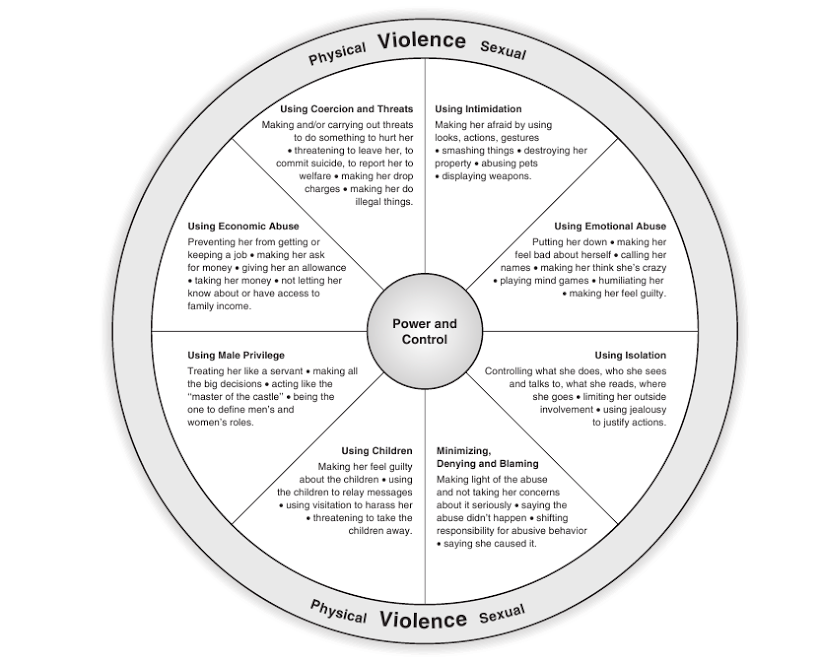The power and control wheel is a way of visually representing the tactics typically used by men who batter (see Figure 1). Batter means the ongoing pattern of violence, coercion, and abuse in an intimate relationship.
Figure 1. Power and Control Wheel

The graphic was created in 1982 by Pence, McDonnell, and Paymar as part of a curriculum for a court-ordered program for batterers. It was developed out of the experiences of battered women attending support and educational groups in the working-class town of Duluth, Minnesota. These women were asked, “What do you want taught in court-ordered groups for men who batter?” Their answers spoke to the need to bring the complex reality of battering out into the open. That is, the lived experience of what actually goes on in a battering relationship needed to be recognized and exposed. As the designers probed, women began to talk about the tactics their partners used to control them. Violence was commonplace. Less recognized but equally significant were other tactics of power, including money, the children, emotional and psychological put-downs, undermining self-esteem and other social relationships, constant criticism of women’s mothering, intimidation, and various forms of expressing male privilege. Over the weeks, the designers revised and adjusted the graphic until the groups of women were satisfied that the wheel captured their experience of living with a violent abuser.
The wheel is not a theory. It is a conceptual tool. It helps people see the patterns in behavior and their significance. It is not intended to capture every tactic of control, just primary tactics. Nor will all empirical cases correspond exactly to the wheel. The wheel was based on women’s experience in heterosexual relationships. The battered women did not identify a desire for power or control as motivating their partners to engage in these behaviors. Rather, batterers gained power and control in the relationship as an outcome of those behaviors.
By 1984, Pence, Paymar, and McDonnell concluded that identifying positive and not just negative behaviors in their training program for batterers could help men to change. Following their earlier method, they then developed the equality wheel to describe behaviors that characterized intimate relationship based on equality. In 1995, Lakota users of the two wheels adapted the shape of the power and control wheel to that of a triangle rather than a wheel (Pine Ridge, Sacred Circle Project). The triangular shape better fits the originators’ understanding of how, in battering relationships, violence and its accompanying tactics of power are intended to establish and maintain dominance over a victim. The tactics do not in and of themselves constitute battering. Battering involves the patterned and intentional use of these tactics to control the victim’s autonomy and to deny her a life free of fear and intimidation.
The wheels have been translated into over 40 languages. It is sometimes culturally modified as, for example, in the Hawaiian modification where the notion of balance replaces that of equality. The graphic has struck a chord among women worldwide.
Bibliography:
- Pence, E., & Paymar, M. (1993). Education groups for men who batter. New York: Springer.
- The Duluth Model Wheel Gallery: https://www.theduluthmodel.org/
This example Power and Control Wheel Essay is published for educational and informational purposes only. If you need a custom essay or research paper on this topic please use our writing services. EssayEmpire.com offers reliable custom essay writing services that can help you to receive high grades and impress your professors with the quality of each essay or research paper you hand in.




